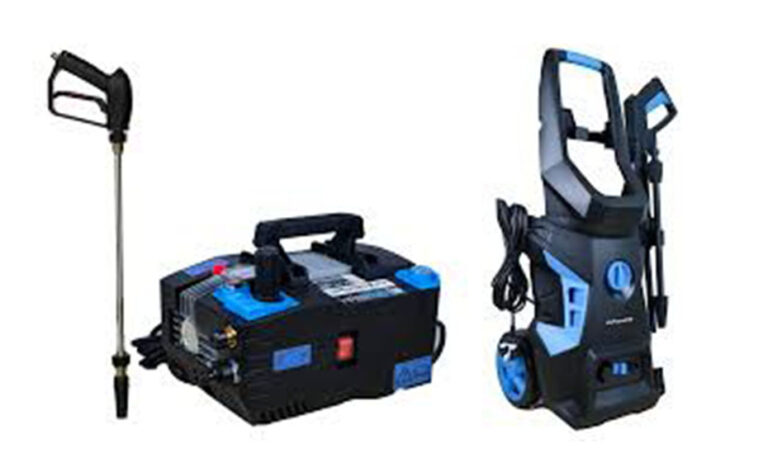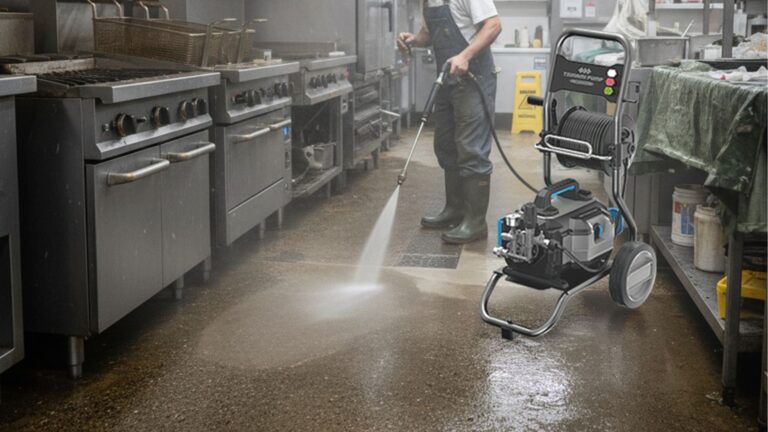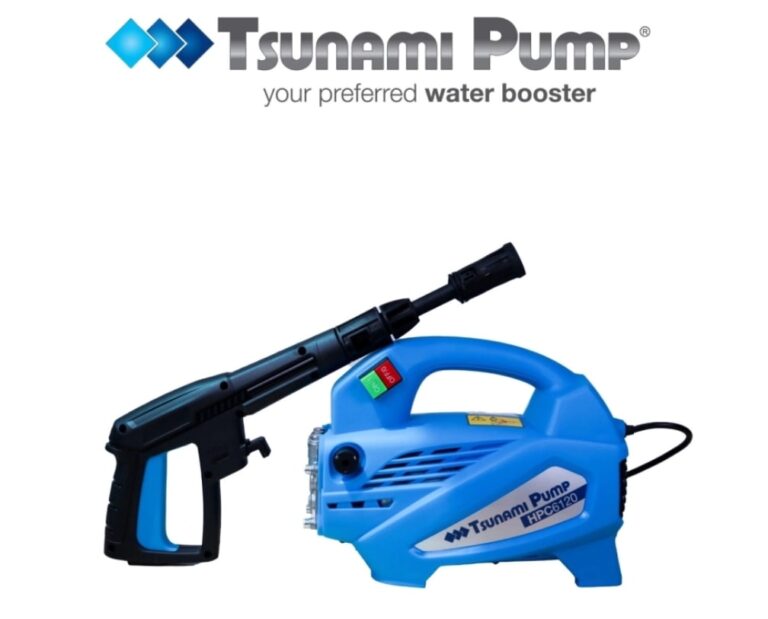Whether you’re blasting mud off your 4WD, prepping your patio for a family BBQ, or scrubbing algae from your fish pond, water pressure cleaners offer a fast and efficient solution. But with so many types, models, and pressure ratings out there, how exactly do you choose the right one?
In this guide, we’ll break down:
- The types of high-pressure water cleaners
- Their power and performance differences
- Ideal use case scenarios
- Buying tips suited for Malaysian homes, farms, and businesses
Table of Contents
What Is a High-Pressure Water Cleaner?

A high-pressure water cleaner, also known as a high-pressure washer, is a machine that uses a motor or engine to pressurise water and forcefully spray it through a nozzle. This high-pressure water stream effectively dislodges stubborn dirt, grime, algae, grease, mould, and even flaking paint from surfaces.
Unlike a standard garden hose, a pressure cleaner delivers significantly greater cleaning power while using less water. Its efficiency makes it ideal for everything from washing cars and patios to cleaning heavy-duty equipment or farm machinery.
Types of High-Pressure Water Cleaners
Let’s look at the common categories, their strengths, and best uses:
| Type | Power Source | Pressure Range | Best For |
|---|---|---|---|
| Electric | Plug-in (230V) | 70–140 bar | Home cleaning, car wash, light dirt |
| Petrol | Petrol engine | 140–275+ bar | Farms, construction, oil, grease |
| Battery | Rechargeable battery | 55–105 bar | Mobile car wash, minor jobs |
| Hydraulic | Tractor/industrial connection | 175+ bar | Agriculture, commercial use |
| Industrial Diesel | Diesel engine | 210–345+ bar | Heavy-duty site work |
Note: Tsunami Pump primarily focuses on electric models, but we include others here for comparison.
Whether you’re a homeowner looking for an easy way to wash your car or a farmer needing to blast mud off machinery, choosing the right type of water pressure cleaner makes all the difference. Understanding the power source, pressure range, and best use case helps you match the cleaner to the job, ultimately saving time, water, and effort in the long run.
What Do Power Ratings Really Mean: Bar vs. PSI vs. Flow Rate
Getting the right pressure cleaner for the right job without wasting money or damaging surfaces. Here’s how each spec matters:
Bar (Pressure): The Standard in Malaysia
In Malaysia, bar is the most commonly used measurement of water pressure for cleaners. It represents the force with which water exits the nozzle.
| Pressure Range | Ideal For |
|---|---|
| 70–100 bar | Light-duty tasks: washing cars, bicycles, tiles |
| 140–200 bar | Medium-duty: patios, drains, gutters, fences |
| 240+ bar | Heavy-duty: stripping paint, engine grime, farms |
It’s important to note that higher pressure is not always better. Using too much pressure on delicate surfaces (like car paint) can cause damage. A good all-rounder for most Malaysian homes is around 130–160 bar — strong enough for daily cleaning but safe for painted or delicate surfaces.
PSI (Pounds per Square Inch): For Reference
PSI is more common internationally. It measures the same concept of how forcefully the water hits a surface.
To convert: 1 bar ≈ 14.5 PSI
So, a 150 bar unit equals about 2175 PSI, which is great for moderate cleaning tasks.
Flow Rate (LPM or GPM): Measures Volume
Flow rate, often shown as Litres Per Minute (LPM) or Gallons Per Minute (GPM), tells you how much water is delivered. It affects how fast you can clean an area.
| LPM Range | Performance Notes |
|---|---|
| 5–8 LPM | Home use (cars, bikes, outdoor furniture) |
| 9–12 LPM | General cleaning (floors, drains, mildew) |
| 13+ LPM | Industrial use (construction, farming, grease) |
A high bar with a low flow rate gives narrow power, ideal for targeting stubborn grime. On the other hand, medium bar with a high flow rate covers large surfaces faster, ideal for rinsing mud off driveways or washing trucks.
Use Case Examples
- 125 bar @ 8 LPM: Home patios, garage tiles, or washing your car without chipping paint.
- 180 bar @ 10 LPM: Schools, office courtyards, café walkways where area coverage and moderate force are needed.
- 250 bar @ 15 LPM petrol-powered unit: Built for large-scale use such as palm oil mills, fish markets, fleet depots, or muddy farms.
Best Use Cases For High-Pressure Washers in Malaysia
Choosing the right water pressure cleaner depends heavily on where and how you plan to use it. Here are some real-world scenarios across Malaysia with recommended machine types and pressure ratings to guide your decision.
- Home Use (Cars, Patios, Tiles, Roofs)
- Recommended: Electric washers (e.g., 90–125 bar)
- Why: Quiet, plug-in, lightweight
- Use Case:
- Monthly car washes
- Cleaning tile grouts
- Washing air cond condenser units
- Moss removal during rainy season
- Kebun & Small Farms
- Recommended: Petrol washer, 140–200 bar
- Why: No need for plug points. Higher pressure clears mud, animal areas more easily.
- Use Case:
- Washing chicken coops or goat barns
- Cleaning tools and plastic trays
- Spraying concrete water tanks
- Workshops / Mechanic Garages
- Recommended: 200 bar petrol or diesel washer
- Why: Can clean engine bays, remove oil stains
- Use Case:
- Degreasing parts
- Floor washing
- Tools sanitisation

- Restaurants or F&B Establishments
- Recommended: 100–140 bar electric washer with detergent tank
- Why: Suited for cleaning grease in kitchens or back alleys
- Use Case:
- Grease traps
- Outdoor drain cleaning
- Floor hygiene
- Construction Site or High Traffic Industrial Areas
- Recommended: 275+ bar petrol/diesel washer
- Why: Frequent handling of cement dust, mud, hardened grime
- Use Case:
- Equipment washing
- Vehicle cleaning before site exit
- Removing dried cement splashes
- Mobile Car Wash Business
- Recommended: Compact petrol or battery-powered
- Why: Portable and saves water
- Use Case:
- Customer house visits
- Motorcycle cleaning
- Add-on services like waxing
Whatever the scenario, there’s a pressure cleaner built for your needs. The right fit helps avoid overkill, save water and electricity, and ensure long-term reliability.
What Features and Accessories You Should Consider for Your Higher-Pressure Water Cleaner
So you’ve found your water pressure cleaner of choice. Now, let’s look at some features and accessories that can significantly improve your cleaning experience.
| Feature | Why It Matters |
|---|---|
| Detergent Tank | Allows direct application of soap or degreaser Great for greasy surfaces or cars |
| Adjustable Nozzles | Lets you switch between wide spray (gentle rinse) and narrow jet (intense cleaning) |
| Wheels & Portability | Makes it easier to transport the unit across farms, garages, or uneven surfaces |
| Safety Shut-Off | Automatically stops the motor when not in use, extending machine’s lifespan |
These features are more than just nice to have. They are what separate a frustrating wash session from a smooth and effective clean. For example, an adjustable nozzle lets you wash your car gently without damaging paint, then switch to a narrow stream for blasting clogged drains or driveway moss.
Must-Have Accessories
A basic pressure cleaner is only the beginning. Good accessories can make specialised jobs far more efficient:
- Foam lance: Creates thick suds to lift dirt off vehicle surfaces with minimal scrubbing
- Turbo nozzle: Spins a concentrated stream for deep cleaning caked-on grime or moss
- Extension wand: Helps reach rooftops, gutters, or tall machinery safely from the ground
- Surface cleaner: Designed for large, flat areas like patios, car parks, or warehouse floors
When buying accessories, check for compatibility with M22 or Quick-Connect fittings. This gives you more flexibility to buy third-party accessories and prevents you from being locked into a proprietary system.
In short, investing in the right features and accessories upfront means less hassle, less time wasted, and a much more satisfying clean. Your pressure cleaner setup is like a toolkit, meaning the better it’s equipped, the more jobs it can handle with ease.
How to Make Your Water Pressure Cleaner Last Longer in Malaysia

Buying a water cleaner with high and consistent pressure is just the beginning. To make sure your investment goes the distance, especially in Malaysia’s hot, humid, and rain-prone climate, you’ll want to follow some simple but effective maintenance habits. These tips apply whether you’re a homeowner cleaning your driveway or a business relying on pressure washing for operations.
- Always Use the Right Nozzle
Each nozzle is designed for a specific task. Using a narrow-angle nozzle (e.g., 0° or 15°) on a delicate surface can cause damage, while using a wide-angle one (e.g., 40°) on tough grime might be ineffective. Stick to manufacturer recommendations and change nozzles based on the job.
- Always Use the Right Nozzle
- Check for Malaysian Climate-Related Damage
In Malaysia’s tropical climate, high humidity can cause rust or mould growth on unused units. Meanwhile, intense sun exposure can crack hoses and plastic components over time. Store your pressure cleaner in a dry, shaded area, and inspect it more frequently if you live in a coastal or flood-prone zone.
- Check for Malaysian Climate-Related Damage
- Drain After Every Use
Especially in humid environments, leftover water inside hoses or pumps can lead to bacterial buildup, internal corrosion, or algae growth. Always drain and dry out the system after each use.
- Drain After Every Use
- Use Clean, Filtered Water
Sediments in Malaysia’s water supply (especially from tanks or rural sources) can clog or damage pump internals. Using a water filter at the inlet or drawing water from a clean source can extend your pump’s life significantly.
- Use Clean, Filtered Water
- Don’t Let It Idle Too Long
Leaving your pressure cleaner on while not spraying water causes heat buildup in the pump, also known as “bypassing.” Even with a bypass valve, prolonged idling can overheat and wear out components. Turn it off when not actively using it.
- Don’t Let It Idle Too Long
- Service It Regularly
Check and replace O-rings, seals, oil (for petrol/diesel models), and pump valves on schedule. For commercial use, a quick weekly check goes a long way. Look out for leaks, weird noises, or pressure drops, as these are early signs of issues.
- Service It Regularly
- Store It Properly During Long Breaks
If you’re not using it for weeks or months (especially during monsoon season), clean it thoroughly, drain all water, remove attachments, and store it covered or indoors. For electric models, wrap cords neatly and avoid damp spots.
- Store It Properly During Long Breaks
Water pressure cleaners are built tough, but Malaysia’s environment can be equally tough on them. By combining good usage habits with a little weather-conscious care, you’ll not only extend the life of your machine but also maintain consistent cleaning performance all year round.
Choose the Water Pressure Cleaner That Suits Your Lifestyle
From homeowners in suburbs to farmers and mechanics across Malaysia, pressure cleaners have a place not just for convenience, but the ability to do the job right, faster, and cleaner.
And whether you’re washing algae off a tiled porch, spraying mud off a fleet of motorcycles, or cleaning a goat pen after monsoon rain, using the right power, performance, and type of cleaner makes all the difference.
Looking for help choosing your unit? Talk to us or browse our product page to compare models and accessories that fit your cleaning needs in Malaysia.


